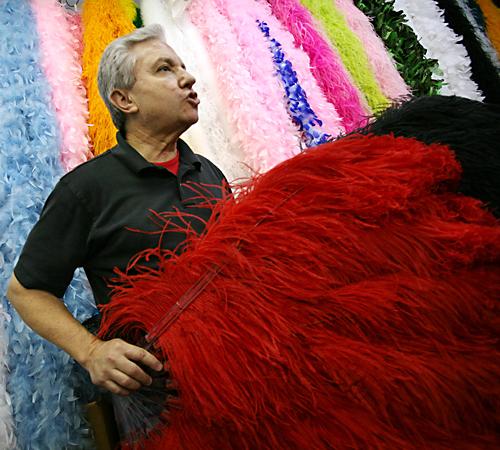Drag queens, Big Bird dressed by ‘feather man’

September 27, 2007
NEW YORK – Drag queens, carnival kings, Big Bird and John Travolta are all in a day’s work to Jon Coles, whose company has outfitted all of them with feathers.
Coles has been vice president and general manager at American Plume & Fancy Feather Company in New York’s garment district for 29 years, ever since the company’s owners, his friends Anthony and Elizabeth Trento, convinced him the feather business would pay better than his previous profession, teaching.
When he started, imports weren’t as common and New York’s feather dealers were distrustful of each other. While cheaper imports have grown since then, the city’s feather dealers have – forgive us – flocked together.
“When I first entered the business, everyone was very secretive,” Coles said. “After a few years of this, I said, ‘This is ridiculous. I buy from these people, they buy from me. We should be friendly.’ So I set up a breakfast.”
He says he hasn’t paid for one since. If he’s out of the office for two days, the competition calls to tease him about his lavish vacation when he comes back.
Get The Daily Illini in your inbox!
Broadway stars swan about in American Plume feather boas and Vegas showgirls titillate with the company’s large ostrich feather fans. Coles talks feathers on a cordless phone while he walks the office, which is a cement-floored, low-glamour spot, except for the riot of feathers: Walls of boas in a carnival of colors, standing racks hung with feathers and boxes and bags of dyed feathers, with samples glued to the outside of the boxes.
He’s had celebrity customers, including Uma Thurman, the model Iman and Travolta, who wore an American Plume boa in the movie “Hairspray.”
But Big Bird remains a favorite client for Coles, a compact, enthusiastic 62-year-old. If he were a Muppet, he’d be Fozzie Bear.
“I’ve seen the inside of Big Bird’s costume; it’s like a jet plane,” he said. “He has to rely on looking out of a hole in his neck. Monitors show what’s at Big Bird’s eye level, what’s at his feet.”
Big Bird is mostly made of large feathers from poultry plants that process 45-pound turkeys, which are hard to find, since most people eat smaller turkeys.
The feathers are dyed two shades of yellow, a deep yellow base and a lighter gold tip, at American Plume’s Pennsylvania dyeing facility. They are either picked up in person or sent, standard shipping, to Sesame Workshop, which backs them with a filmy, strong fabric, numbers them and uses them to build Big Bird.
A sign on the wall reads: 100 peacock feathers for $25. One or two cost 75 cents apiece. Decor runs to pictures and posters of feathery costumes, stars and shows, like Sandra Bullock in a hot pink boa in “Miss Congeniality II,” an American Plume job.
The company can have sales of anywhere from $2 million to $5 million a year, depending on how prominent feathers are in fashion and pop culture. When “Moulin Rouge” was released in 2001 moms planning Sweet 16 parties ordered boxes of red decorative feathers. That was a good year.
The company sells to theaters, cruise ships, Vegas shows, party planners, craftspeople and fly fishing lure makers. Coles estimates it sold about $10,000 to $20,000 worth of feathers this year for revelers in New York’s West Indian Day Carnival Parade, a Labor Day parade that may be the city’s most feather-intensive one-day event.
“A lot of them have feathers from previous years,” he said.
As for the rest of the year, “Certain times, you’re running only for theaters,” he said. “Then there could be a time when, two full months, all we do is Bally’s Jubilee show.”
The company’s feathers are dyed in Pennsylvania, then worked New York. Turkey feathers come from the U.S., ostrich feathers come from farms in Africa and rooster and pheasant feathers come from China.
American Plume has about 15 employees total in New York and Pennsylvania, many of whom have 20-plus years in the feather business. Most of the workers have no garment industry experience, but some have worked in beauty salons (some feathers must be hand curled) or sewn their children’s clothes.
One family has had three successive sisters work at American Plume; the second sister joined the company after the first bought a house in Pennsylvania and left. Then the second sister moved to Pennsylvania, too, and the third sister joined the company, Coles said. Another sister has stayed with the company for more than 20 years.
A recent morning at the New York workshop was quiet, until Tom Beall, an assistant to Tony-award winning costume designer William Ivey Long, came in around 10 a.m. with a request for boas for that day’s dress rehearsal of the show “The Ritz,” a slamming-door farce that takes place in a gay bathhouse.
He needed two boas for the star, Rosie Perez, who plays the role of the bathhouse chanteuse. One boa would go with a light-blue gown and another would go with a leopard-print gown.
Feather boas are made by stripping feathers off the quill, putting the fluff, called the flues, in a clamp, then sewing them on a cotton cord with a marabou feather center added to hide the cord. The boa is twisted on a 50-year-old machine.
Once Beall had picked out the feathers, the question became how much glitter would go with them and how big the boas would be.
“Do you want a kiss of Lurex or a lot of Lurex?” Coles asked. “Are we talking two-ply Ostrich or four?”
The final decision would be made by Long, whose work was once described as “between taste and travesty” by an especially acerbic theater critic.
“It’s a straight play, but there are 25 cast members,” Beall said.






